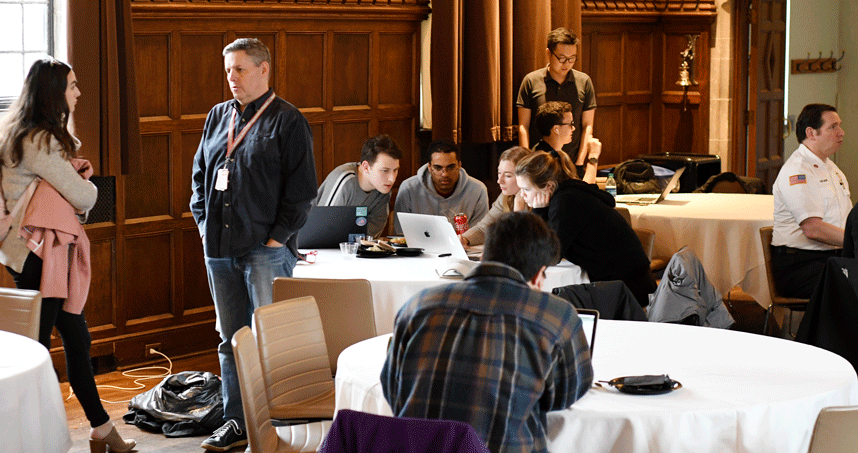Hackathon Explores Trends in Reported Red Cross Incidents
Students analyzed data as part of IEMS 365: Analytics for Social Good course
While the American Red Cross is known for responding to large national disasters like hurricanes and wildfires, the majority of the organization’s work occurs at the local level.
After years of growth, the number of reported incidents — most of which are home fires — in the Red Cross’s Chicago & Northern Illinois Region are down more than 10 percent over the last eight months. Students in the IEMS 365: Analytics for Social Good course turned to the data to find out why.
Open to all Northwestern juniors and seniors, Analytics for Social Good annually features a nearly even split between Northwestern Engineering students and non-engineering majors from across the University. The course challenges students to use their unique academic backgrounds — from industrial engineering to statistics to journalism — to work together to gain insights from data that can benefit communities.
During the course’s culminating project, a 48-hour hackathon, students worked in interdisciplinary teams to apply quantitative and qualitative data analysis to explain why reported house fires have declined so significantly.
Finding Connections Among the Data
Junior Christina Parker and her team studied the drop in reported fires in relation to changes in population income averages across Chicago-area ZIP codes. Comparing the data with recent labor reports, the group found that the decrease in responses could be due to improved economic standing in Chicago-area neighborhoods.
“With unemployment down and per capita income up, it’s a sign that people are working and earning more money,” said Parker, who majors in social policy and global health. “Energy is also cheaper, meaning more people can afford central heating and move away from using space heaters, which is a leading cause of home fires.”
Parker’s group was one of eight teams to present their insights at the hackathon’s final presentations on March 14. During the previous two days, students applied techniques in data analysis to several large datasets provided by the Red Cross, including records of Red Cross smoke alarm installations in Chicago neighborhoods and incident reports dating back to 2014. Teams bolstered their research through interviews with Red Cross volunteers and members of the Evanston Fire Department.
Bringing Together Diverse Partners
 Northwestern Engineering’s Karen Smilowitz has taught the class since it launched in 2015. She credits several collaborators for the course’s success, including Jim McGowan, director of information management and situational awareness at the Red Cross; Tony Surma, Chief Architect - US One Commercial Partner at Microsoft and co-founder of Humanitarian Toolbox; Katie Freeman, director of operations at Hagerty Consulting, and Kelsey Rylan, geospatial and data analyst at Northwestern University Libraries.
Northwestern Engineering’s Karen Smilowitz has taught the class since it launched in 2015. She credits several collaborators for the course’s success, including Jim McGowan, director of information management and situational awareness at the Red Cross; Tony Surma, Chief Architect - US One Commercial Partner at Microsoft and co-founder of Humanitarian Toolbox; Katie Freeman, director of operations at Hagerty Consulting, and Kelsey Rylan, geospatial and data analyst at Northwestern University Libraries.
“With their support, we have been able to engage students in challenging and impactful applications of analytics,” said Smilowitz, the James N. and Margie M. Krebs Professor in Industrial Engineering and Management Sciences. “It's been amazing to see how the course continues to evolve and improve.”
Insights that Won’t be Wasted
Another team at the hackathon used the data to study trends in the number of categorized “minor” fires compared to previous years. The team plotted the location of minor fires on a map of Chicago-area ZIP codes and found an association between concentrated areas where the Red Cross installed smoke alarms through its Home Fire Campaign and a decrease in minor fires. The map also highlighted ZIP codes where multiple fires had occurred, signaling where additional Red Cross support could be beneficial.
“Red Cross’s programs to install smoke detectors in repeat areas really work,” said Jacob Stein, a junior studying learning and organizational change and statistics. “A ‘double-check’ policy where volunteers focus on ZIP codes that have experienced more than one fire could give the Red Cross direction as it works toward its goal to reduce fires.”
McGowan thanked the students for their hard work, and promised that their insights will be put to use.
“We posed a simple question, but it’s one I think you realize now is difficult to answer,” McGowan said. “The work you’ve done doesn’t stop here. Your analysis will help us moving forward so we can continue to provide better services for our disaster prevention initiatives.”


